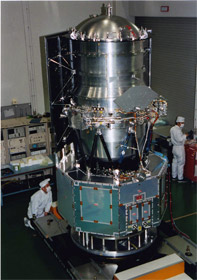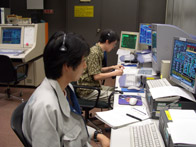
Q. How did you feel when the cover of the telescope - the aperture lid - was jettisoned?
The aperture lid was closed on launch and had to be jettisoned in orbit. This is a very critical operation, so we were quite nervous.
To detect faint infrared radiation from stars, the telescope must be kept very cold. It is cooled down to 6 Kelvin, which is equivalent to -267?C. This condition is not easy to maintain. When the lid is closed and the telescope is protected, it can face the Sun or the Earth. But once the lid is removed, the telescope must avoid bright light or heat, even for a moment. Obviously, facing the Sun is out of question. Earth, which is also very bright in the infrared, is another big source of heat, so we cannot point the telescope toward the Earth either. However, since the aperture lid weighs 30 kg, jettisoning it would alter the attitude of the satellite. To avoid pointing the satellite in the direction of the Sun or the Earth, we needed to calculate the reaction carefully in advance.
 |
| Infrared astronomical satellite Akari in the laboratory. One can see the telescope's cover, or aperture lid at the top |
 |
| Akari operation room |
Akari couldn't begin its sky survey unless the lid was jettisoned, so we astronomers had been waiting for its jettison impatiently. The jettison was originally scheduled two weeks after the launch, but we found that the solar sensor, which is a part of the attitude control sensors, was not working properly in orbit. We were then forced to control the satellite's attitude without the sensor and to rewrite some of the satellite's software. We had to be very patient, because there would have been no second chance if we had failed. So we carefully tested the satellite's operation, and when every function of the new software was confirmed, we finally jettisoned the lid. It was April 13th. Two months had already passed since the launch. The success of the operation was a great relief to us.
We had been very nervous after the launch, but every thing is going very well now.
Q. How is Akari being operated?
Akari's operation center is at the Sagamihara Campus. Data from Akari is not received at Sagamihara, but at the Uchinoura Space Center in Kagoshima. The data is also acquired by antennae all over the world. During the early post-launch phase, we used antennae in Australia, Chile, Spain, Norway, and Sweden. Currently, the main antennae are at Uchinoura and in Sweden. Although the Sagamihara Campus doesn't have antennae for receiving data, the campus is connected to all of these antennae around the world, and is the center of operations for Akari.
We send commands to Akari in real time using the antennae at Uchinoura. The spacecraft is flying over the night-day terminator zone on Earth, and Uchinoura can communicate with Akari twice a day; in the morning and in the evening. Morning communication can start at 5 o'clock, which means that team members have to get up around 4:00 a.m. for their shift. Actually, it was my turn this morning. I must admit that it is sometimes hard to get up so early, but I feel very relieved when I confirm that data transmitted from the satellite shows that Akari is doing fine.
| 1 2 3 4 |